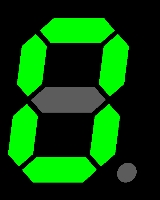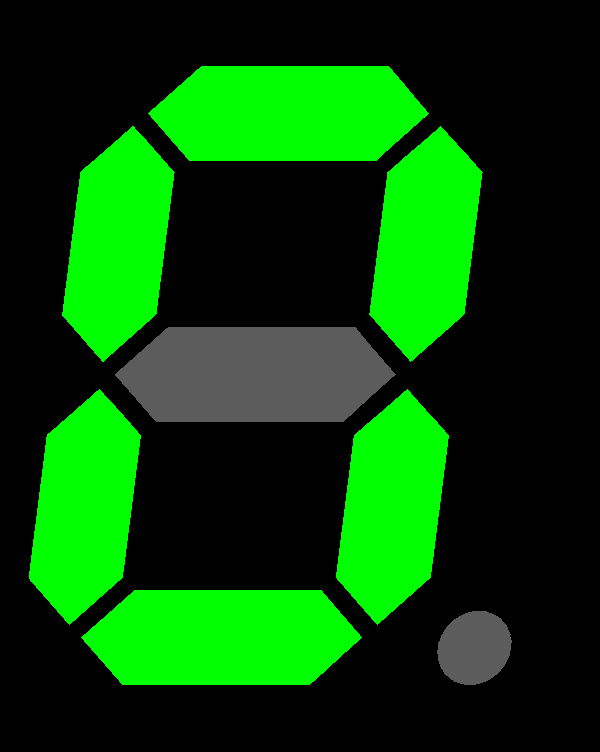
Dihedral prime
Encyclopedia
A dihedral prime or dihedral calculator prime is a prime number
that still reads like itself or another prime number when read in a seven-segment display
, regardless of orientation (normally or upside down), and surface (actual display or reflection on a mirror). The first few decimal
dihedral primes are
The smallest dihedral prime that reads differently with each orientation and surface combination is 120121 which becomes 121021 (upside down), 151051 (mirrored), and 150151 (both upside down and mirrored).
 The digits 0, 1 and 8 remain the same regardless of orientation or surface (the fact that 1 moves from the right to the left of the seven-segment cell when reversed is ignored). 2 and 5 remain the same when viewed upside down, and turn into each other when reflected in a mirror. In the display of a calculator that can handle hexadecimal
The digits 0, 1 and 8 remain the same regardless of orientation or surface (the fact that 1 moves from the right to the left of the seven-segment cell when reversed is ignored). 2 and 5 remain the same when viewed upside down, and turn into each other when reflected in a mirror. In the display of a calculator that can handle hexadecimal
, 3 would become E reflected, but E being an even digit, the 3 can't be used as the first digit because the reflected number will be even. Though 6 and 9 become each other upside down, they are not valid digits when reflected, at least not in any of the numeral systems pocket calculators usually operate in.
Strobogrammatic prime
s that don't use 6 or 9 are dihedral primes. This includes repunit primes and all other palindromic prime
s which only contain digits 0, 1 and 8 (in binary
, all palindromic primes are dihedral). It appears to be unknown whether there exist infinitely many dihedral primes, but this would follow from the conjecture that there are infinitely many repunit primes.
The palindromic prime 10180054 + 8×(1058567−1)/9×1060744 + 1, discovered in 2009 by Darren Bedwell, is 180055 digits long and may be the largest known dihedral prime .
Prime number
A prime number is a natural number greater than 1 that has no positive divisors other than 1 and itself. A natural number greater than 1 that is not a prime number is called a composite number. For example 5 is prime, as only 1 and 5 divide it, whereas 6 is composite, since it has the divisors 2...
that still reads like itself or another prime number when read in a seven-segment display
Seven-segment display
A seven-segment display , or seven-segment indicator, is a form of electronic display device for displaying decimal numerals that is an alternative to the more complex dot-matrix displays...
, regardless of orientation (normally or upside down), and surface (actual display or reflection on a mirror). The first few decimal
Decimal
The decimal numeral system has ten as its base. It is the numerical base most widely used by modern civilizations....
dihedral primes are
- 2, 5, 1111 (number)11 is the natural number following 10 and preceding 12.Eleven is the first number which cannot be counted with a human's eight fingers and two thumbs additively. In English, it is the smallest positive integer requiring three syllables and the largest prime number with a single-morpheme name...
, 101101 (number)101 is the natural number following 100 and preceding 102.It is variously pronounced "one hundred and one" / "a hundred and one", "one hundred one" / "a hundred one", and "one oh one"...
, 181181 (number)181 is the natural number between 180 and 182.-In mathematics:* 181 is an odd number* 181 is a centered number** 181 is a centered pentagonal number** 181 is a centered 12-gonal number** 181 is a centered 18-gonal number...
, 1181, 1811, 18181, 108881, 110881, 118081, 120121, 121021, 121151, 150151, 151051, 151121, 180181, 180811, 181081 .
The smallest dihedral prime that reads differently with each orientation and surface combination is 120121 which becomes 121021 (upside down), 151051 (mirrored), and 150151 (both upside down and mirrored).

Hexadecimal
In mathematics and computer science, hexadecimal is a positional numeral system with a radix, or base, of 16. It uses sixteen distinct symbols, most often the symbols 0–9 to represent values zero to nine, and A, B, C, D, E, F to represent values ten to fifteen...
, 3 would become E reflected, but E being an even digit, the 3 can't be used as the first digit because the reflected number will be even. Though 6 and 9 become each other upside down, they are not valid digits when reflected, at least not in any of the numeral systems pocket calculators usually operate in.
Strobogrammatic prime
Strobogrammatic prime
A strobogrammatic prime is a prime number that, given a base and given a set of glyphs, appears the same whether viewed normally or upside down. In base 10, given a set of glyphs where 0, 1 and 8 are symmetrical around the horizontal axis, and 6 and 9 are the same as each other upside down, A...
s that don't use 6 or 9 are dihedral primes. This includes repunit primes and all other palindromic prime
Palindromic prime
A palindromic prime is a prime number that is also a palindromic number. Palindromicity depends on the base of the numbering system and its writing conventions, while primality is independent of such concerns...
s which only contain digits 0, 1 and 8 (in binary
Binary numeral system
The binary numeral system, or base-2 number system, represents numeric values using two symbols, 0 and 1. More specifically, the usual base-2 system is a positional notation with a radix of 2...
, all palindromic primes are dihedral). It appears to be unknown whether there exist infinitely many dihedral primes, but this would follow from the conjecture that there are infinitely many repunit primes.
The palindromic prime 10180054 + 8×(1058567−1)/9×1060744 + 1, discovered in 2009 by Darren Bedwell, is 180055 digits long and may be the largest known dihedral prime .

